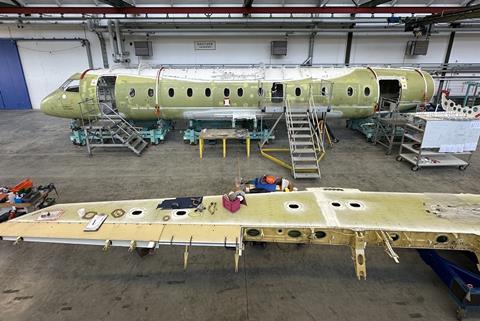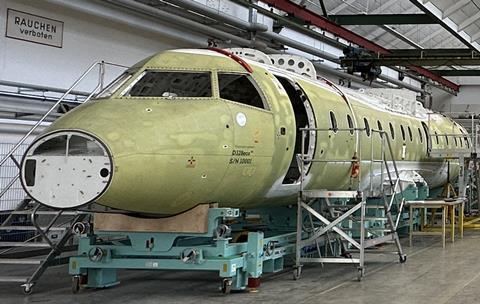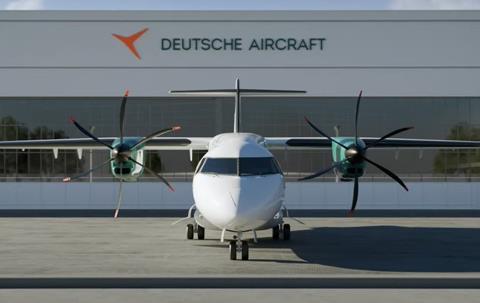German turboprop manufacturer Deutsche Aircraft is justifying an ambitious outlook for its D328eco, arguing that there are fewer rival manufacturers pursuing the primary markets.
Deutsche Aircraft, in its latest full-year financial statement, says its planning for the D328eco “assumes” sales of 1,000 aircraft, based on various market studies – a four-figure target some 10 times larger than the production run of the original turboprop Dornier 328.
“We’ve done a lot of independent research, rather than just coming up with the number we want,” Deutsche Aircraft chief executive officer and managing director Dave Jackson tells FlightGlobal.
He says that the outlook spans 20 years and covers three main areas. The replacement market has around 2,000 ageing 30- to 50-seat turboprops, he claims, but several previous manufacturers – such as Saab, BAE Systems, Embraer and Bombardier – are no longer producing aircraft in the sector.
Jackson says there is a “mature customer base” of aircraft operating in established markets, and opportunities in growth markets such as India, China and the Asia-Pacific region, as well as the possibility of replacing small regional jets elsewhere.
Multi-mission activity – including military, maritime and medical work – where, he says, the current 328 is “pretty successful”, offers another sales avenue.
“The fact that these aircraft are still operating, and people haven’t gone to a larger aircraft, shows there’s a utility value in this type of aeroplane, in the turboprop,” says Jackson.

Deutsche Aircraft is progressing with its first flight-test prototype, known as TAC1, the fuselage for which is being constructed using two separate 328 fuselages – the nose and empennage from one, and the centre section from the other.
This enables the company to build a hybrid stretched D328eco fuselage, some 2.2m longer than the 328’s, without the use of plugs.
“That the first real mark that people believe in, when they get past the fantastic 3D graphics and imagery… to say ‘this thing’s actually made of metal’,” says Jackson. “[The fuselage is] now together, we’re just doing the final splicing.”
He acknowledges that TAC1 will be “a bit of a Frankenstein”, a mix of new components including the engines while older parts, such as the braking system, are likely to be retained for prototype purposes.
“We want to get moving,” he says. “It’s not a production prototype in that sense, it’s a test aircraft to look at the aerodynamic performance of the stretch.”

TAC1 is “the one we want to get into the air quickly”, Jackson says, adding that the company is “not short of material” and all the parts required for the prototype are either ordered or already in stock.
Deutsche Aircraft expects to fly TAC1 in the third quarter of next year. The second prototype, TAC2, is being “kitted”, says Jackson, with all the components needed being brought together.
“We’re fortunate that we have wings, enough fuselage sections,” he says. “We’re focusing on finishing splicing on TAC1, getting the wing on. Then we’ll start to move on aerostructures for TAC2.”
TAC2 will primarily be used to evaluate aircraft systems.
The third prototype, TAC3, will be a production proxy representing the serial aircraft, including a fuselage built to the stretched length from the outset. “We can use a bit of a mix of parts,” says Jackson. “But primarily we’ll be using fundamentally all-new parts. It’ll be the other end of the spectrum from TAC1.”
TAC3 will be built on a line in Leipzig. Ground work for the facility is already completed and Deutsche Aircraft expects the building to be ready in November next year, with assembly work stations installed in parallel.
The Leipzig line will start serial production at the end of 2027 after the company, earlier this year, pushed back the entry-into-service date.
Jackson says the postponement is due to a “mixed bag” of reasons, including geopolitical stress, inflation, and supply-chain challenges – as well as regulatory changes which need to be reflected in the D328eco.
He adds that the delay has also enabled Deutsche Aircraft to consult with its customer advisory board with a view to acting on feedback from potential operators regarding possible enhancements – such as improved short-field performance, particularly for difficult environments, and cabin layout changes.

Given the persistent strain on resources, Jackson says Deutsche Aircraft has had to convince suppliers of the D328eco’s market expectations. “They’re all looking at many different programmes that are out there,” he says. “You’re almost having to sell yourself to a supplier, that they should back your programme rather than others.”
But he states that 95% of the supply chain is contracted. “I think that’s pretty good,” he says, adding that the company is working with some “highly-motivated” second-tier suppliers that are aiming to be first-tier in the future. “They have room to grow, and aspirations to grow.”
Along with the Pratt & Whitney Canada engines, the D328eco will have a Garmin cockpit and Heggemann landing-gear assembly.

“We didn’t want to make so many changes [to the 328] otherwise you might as well have done a clean-sheet [aircraft],” says Jackson. “We’ve been fortunate that we’ve existing suppliers who’ve come on board with us again and, in some cases, we’ve found new suppliers and players in the game.”
Jackson is confident that staff numbers are in line with planned levels, despite the intensely-competitive marketplace for personnel, particularly in Germany.
“We’ve had to go further afield. We’ve about 40 different nationalities working in Oberpfaffenhofen,” he says. “I tell everybody we have a diverse culture – but also a diverse corporate culture, because we’ve been able to pick up people from Embraer, Bombardier, Mitsubishi, all these different companies.”
He adds that the employee situation appears to be stabilising, claiming the number of job applications is exceeding availability by a factor of around 20. “They’ve got more ‘stickability’,” he says. “As programmes are maturing, or not maturing, in the marketplace, we’re seeing a little less job-hopping.”
Certification rules limit the scope of modification to establish the derivative D328eco, and Jackson says the company does not want to be “distracted” from focusing on the target sector. But he says that, in future, the company can either look at whether the D328eco becomes the basis of a family, or adopts advanced technologies as they become available. “I think the jury’s still out on all of that,” he says.


























